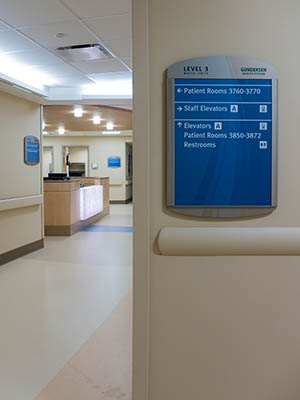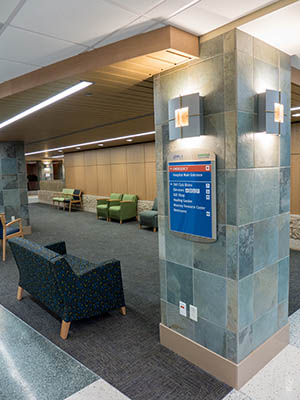Balance in the Built Environment
 Every person is different. While this may not be breaking news, it is a wayfinding reality that must be addressed to reduce patient stress in a health care environment. Achieving this requires first an understanding of how people navigate, then implementing navigational tools. Some people are comfortable reading a map, while others use landmarks to navigate. Some can remember detailed verbal directions, while others lose track after their first turn. Some remember words, others colors. Each person brings a preference and a set of limitations to the task of finding their way. And if they are lost, their experience is frustrating.
Every person is different. While this may not be breaking news, it is a wayfinding reality that must be addressed to reduce patient stress in a health care environment. Achieving this requires first an understanding of how people navigate, then implementing navigational tools. Some people are comfortable reading a map, while others use landmarks to navigate. Some can remember detailed verbal directions, while others lose track after their first turn. Some remember words, others colors. Each person brings a preference and a set of limitations to the task of finding their way. And if they are lost, their experience is frustrating.
In the world of health care design, consultants from multiple disciplines work to resolve these issues. In many cases, a division of labor exists between interior design and wayfinding design. An interior designer is concerned with the context, durability, functionality and safety of the building itself, while the wayfinding designer creates connections between communications and the built environment. Interior designers incorporate intuitive wayfinding cues that enhance and beautify, while wayfinding specialists place messages that orient, inform and direct. Each of these disciplines address a range of visitor needs. Thoughtfully considered together, the results can be spectacular.
For Gundersen Health System, wayfinding was complex. With multiple buildings built over the course of the organization’s more than 100-year history, it was easy for patients and visitors to lose their way. To find a solution, the organization brought together a multidisciplinary team including service excellence, construction engineering, facilities and interior design to partner with their wayfinding consultant, Corbin Design. Working together, they tested concepts for wayfinding with patients, visitors and staff to help them visually and cognitively separate each level in the main medical center. At the same time, it was important that the wayfinding logic, language and graphics be consistent throughout each building.
Wayfinding Concepts
The first task was to simplify the logic of the campus for first-time or infrequent visitors. This started from the moment a patient or visitor parked their vehicle. Parking opportunities and building entrances were defined for specific interior destinations (clinic versus hospital for example) and to create the shortest possible pathway for a given visitor. To help jog one’s memory, Gundersen and Corbin identified public parking areas by color. Sequential letters that begin from primary visitor entrances differentiate each elevator core. Finally, Gundersen and Corbin removed staff information from signage in public areas, and reduced the number of signs overall.
 Once the logic was simplified, the information was presented using a pattern of easily recognizable signage elements that speak quietly in the context of the environment: apparent when you need them, transparent when you don’t. Using the primary blue of the Gundersen Health System brand, the sign standards are consistent in form, scale, location, typography and contrast. They are also ADA/SAD compliant. This fulfilled the requirement for cross-campus consistency.
Once the logic was simplified, the information was presented using a pattern of easily recognizable signage elements that speak quietly in the context of the environment: apparent when you need them, transparent when you don’t. Using the primary blue of the Gundersen Health System brand, the sign standards are consistent in form, scale, location, typography and contrast. They are also ADA/SAD compliant. This fulfilled the requirement for cross-campus consistency.
The signage system was designed using printed inserts, allowing the health system to respond to massive change. Over the course of five years, Gundersen renovated its main clinic, built two parking garages, erected a state-of-the-art 200,000-square-foot hospital and, in 2014, began renovations of its original hospital. The facilities and interior design groups managed the signage changes internally. At the same time, other departments, such as marketing, corporate communications, clinical services and service excellence, developed protocols to address change for each of the ways they communicate to patients and visitors: verbal, print and digital.
Interiors Concepts
To further assist patients and visitors with wayfinding, landmark images in each elevator lobby divide the levels of the medical center. Tied together with wall coverings, furniture, carpeting and lighting throughout the building’s public areas, these images and color palettes not only calm the senses but also create memorable, “speakable” experiences:
Floor 6: River – blues and greens
Floor 5: Fern – blues and greens
Floor 4: Sunrise – terra cotta and yellow
Floor 3: Clouds – blues
Floor 2: Sand – tan, green and terra cotta
Floor 1: Lily Pond – blues and greens (corporate colors)
Floor LL: Bluffs – terra cotta and browns
Taken as a whole, the natural settings depicted serve as visual relief when views to the outside are not available. At the same time, each has distinguishing features that help people remember which floor they’ve accessed.
Along with other landmarks, such as artwork, information desks and seating areas, these visuals create an overall impression of accessible public space. Visitors to Gundersen intuitively know when they’re in an area where the public is welcome and when they’re not based on the strategies in interior design.
Tying it together
By coordinating interiors and wayfinding, Gundersen Health System staff and volunteers now have a complete toolkit to help visitors navigate buildings based on the individual’s preference for maps, landmarks, letters, colors, etc. Now comes the important part: training internal staff to consistently “speak to wayfinding” using those tools.
It’s obvious that in health care environments compassionate people abound. Many times, for lack of a better system, a nurse may give someone directions to a given destination based on what he or she knows rather than what’s best for the patient or visitor. This can result in awkward situations if, for instance, that person is directed to use a patient transport elevator rather than a visitor elevator.
Scenarios such as these can be easily avoided by providing ongoing training to all frontline staff and including wayfinding in new employee orientation. The Gundersen wayfinding system, by virtue of its simplicity and consistency, ultimately helps people provide less information to patients or visitors who are lost. Doing so increases the odds that patients or visitors will find their way, and empowers them to navigate on their own.
There will always be those who are unable to find their way, by virtue of a physical limitation or preference for assistance. In any health care setting, there will always be a cultural imperative to connect with patients and visitors. For these reasons, staff are also encouraged to walk a patient or visitor to their destination whenever possible. This has been a key component of employee communications because connecting with patients and visitors is what Gundersen Health System is all about.
The success of Gundersen’s interior design and wayfinding program lies in the approach that the cross-disciplinary team took to the entire range of wayfinding tools: internal communications and training, interior finishes, lighting, imagery, artwork, color and signage. The Gundersen team built a flexible infrastructure to manage the intricacies of facility change while addressing all aspects of the patient and visitor experience. In the end, they’ve transformed their caregiving culture as well.
Theresa Besse is an interior designer for Gundersen Health System, headquartered in La Crosse, Wis. She is responsible for setting standards and maintaining the interiors, signage and artwork for more than 50 locations across Wisconsin, Minnesota and Iowa. She is a 2006 graduate of Minnesota State University, Mankato.
Mark VanderKlipp, EDAC, is the president of Corbin Design of Traverse City, Mich., a national leader in user-centered wayfinding that has helped health care facilities, educational institutions, cities and corporate clients improve how people access and experience their environments. He has recently served on the international board for the Society for Experiential Graphic Design. VanderKlipp is a frequent speaker, writer and blogger for industry events and publications regarding the advantages and scope of wayfinding projects in both built and digital environments. He is a 1987 University of Michigan graduate, and in 2012 achieved EDAC certification from the Center for Health Design.
